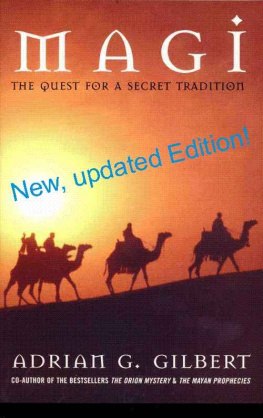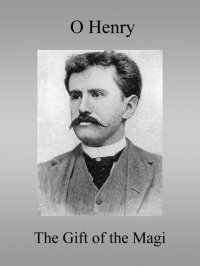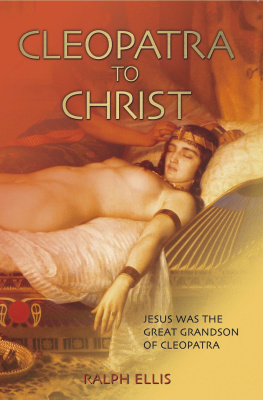Table of Contents
MAGI
The Quest for a Secret Tradition
To the Masters of Wisdom wherever they may be!
All rights reserved: no part of this publication may be reproduced, stored in a retrieval system, or transmitted in any form or by any means, electronic, mechanical, photocopying or otherwise, without the prior written permission of the author.
First published 1996 by Bloomsbury Publishing Plc, London.
This revised, electronic edition published by Adrian Gilbert 2011
Copyright Adrian G. Gilbert 1996 & 2011
ACKNOWLEDGEMENTS
I would like to thank the following people and institutions for their help in bringing this project to fruition.
My old friend John Harvey, who accompanied me on many saddle-sore miles and witnessed the beginning of the quest; the staff of the British Museum, who have always been most helpful most especially Dr Dominique Collon; the Warburg Institute; the Sanliurfa Museum of Archaeology; a big thanks to Mark A. Haney of KlassM Software for his SKYGLOBE computer program which made the unravelling of the Magi mystery possible. (Anyone wanting to obtain a shareware version of the program should contact him at PO Box 1067, Ann Arbor, MI 48106, USA). To John Baldock, who put me onto the amazing Magi sculptures at Autun cathedral; the late Ann Walker and 'White Arrow', for their constant encouragement; my friend Bengt Alfredson, for his extraordinary, astronomically correct painting of The Adoration of the Magi ; and last but not least my wife Dee, who has accompanied me on most of my journeys and been steadfast throughout.
Thanks are due to the following organization for permission to quote from their published works.
To Bennett Books for quotations from the following titles by J. G. Bennett: Deeper Man; Gurdjieff making a new world; Journeys in Islamic Countries; Sacred Influences; The Masters of Wisdom; Witness . To Penguin/Arcana for quotations from P. D. Ouspensky's books, A New Model of the Universe; In Search of the Miraculous ; G. I. Gurdjieff's Meetings with Remarkable men ; Josephus, The Jewish War ; and S. Runciman's, A History of the Crusades . To Routledge & Kegan Paul for M. Boyce's, The Zoroastrians ; Dame Frances Yates' Giordano Bruno and the Hermetic Tradition and Astraea . To Harvard University Press for F. Millar's The Roman Near East . To Oxford University Press for J. Riley-Smith's Oxford Illustrated History of the Crusades. To Oxford at the Clarendon Press for J. B. Segal's Edessa, 'the Blessed City' . To Thames and Hudson Ltd for R. T. Rundle Clark's Myth and Symbol in Ancient Egypt . To Souvenir Press London for Joseph Campbell's The Masks of God Occidental Mythology . To Collins/Fontana for J. Harvey's The Plantagenet's . Thanks also to the many other authors and publishers not listed above whose books have inspired the present work and helped to fertilise my thoughts.
Picture credits .
Thanks are due to the National Gallery, London, for permission to reproduce the following: The Wilton Diptych (artist unknown); The Baptism of Jesus by Piero della Francesca and St Veronica with the Sudarium . To Bengt Alfredson for the Star-correct Adoration of the Magi . All other pictures and diagrams are the copyright of Dee and Adrian Gilbert.
Foreword
The first edition of Magi was published in September 1996. It has subsequently been translated into many languages including German, Spanish, Italian, Japanese, Korean and even Turkish. In the main it has been very well received though, as with all books, it has not been without its critics. Inevitably there were some readers who have criticised it for including too much historical detail while for others there was not enough; some felt it was too academic while others took exception to the adventure quest aspects of it which they felt diluted its seriousness as an academic treatise. My reply to all such critics is the same: Magi is written on many levels; I would urge you to take what you can from it now while leaving yourself the option of coming back later for more. It was and is not intended to be like a novel: read it once and then discard. Rather it is a work that you can come back to again and again, maybe even some years later. Each time you do, you may well find that something that seemed either difficult or irrelevant on first reading, now actually makes more sense. It could even turn out to be the key you need now to further aspects of your own researches.
Needless to say there are one or two things that if I were writing it today, I would put differently. However, on the whole I think it has stood the test of time extremely well. There is really not much, other than occasionally emphasis, that I would change. I have, however, subjected the text to a fairly rigorous edit in order to get rid of as many typos as possible and to put right the occasional, badly phrased sentence.
The themes that I was examining in Magi , the connections between Matthews story of the three wise-men, Gnostic Christianity and the ancient star-religions of the Near East, continue to fascinate me. In 1999, in time to be published for the Millennium in 2000, I wrote a sequel to Magi called Signs in the Sky. This brought up to date the story we had begun in Magi as I was able to show how the same astronomical keys that unlock the mystery of the wise-men story are also pivotal in putting into context the timing of Biblical prophecies for the end-times. Magi , however remains the core text as it presents the historical and logical background to what otherwise may seem like abstract theories.
I hope you will enjoy reading this new, electronic edition as much as I have in preparing if for publication. Of all the books I have written (ten so far!) Magi , perhaps because it is very much my own adventure, remains my favourite. Re-edited and with new material added, I hand it back to you now in the hope that you will find it of benefit, that it will stimulate your own investigations into the major questions of life: why are we here and what might we have forgotten that people of the past took for granted?
Adrian Gilbert
Kent, February 2011.
PROLOGUE
T his world is full of mysteries, some large and some small. Even the most simple of people have their secrets and so too, on a larger scale, does history. Possibly the greatest mystery in the world surrounds the origins of the Christian religion. Who was this man Jesus? Where did he come from? What really was his mission? Unlike the Buddha or Mohammed, whose lives were well documented and who left writings of their own, the historical Jesus Christ continues to be an enigma.
The Biblical story is extremely fragmentary and even if we treat the Gospels as genuine biographies, the light they throw on the historical Jesus is surprisingly limited. Between the ages of twelve and thirty that is, his most formative years, we lose sight of him altogether. If Matthew, Mark, Luke and John knew what happened to him during those critical years of adolescence and young manhood, they are remarkably silent and so indeed is the Church founded in his name. Many people assume, not surprisingly given the context of the Gospels, that Christianity is simply a reformed and updated version of Judaism. After all Jesus was a Jew and indeed, if the genealogy given in the New Testament is to be believed, he was a direct descendant of the legendary King David. His three year ministry was conducted for the most part among the Jews and he was hailed by his followers as the expected Jewish Messiah. Why then, one may ask, is what he taught so very un-Jewish? As a prophet one would expect to read of him haranguing people in the fashion of a Jeremiah or Ezekiel, exhorting them to abandon false gods and to adhere to the Law of Moses. While there are many references in the Gospels to the Old Testament and particularly to the prophecies of Isaiah, these are by no means important elements in the teaching of Christianity. The Jesus we read about is an intelligent, unbigoted man who heals the sick and is happy to eat with sinners. He also takes little interest in the prohibition of work on the Sabbath but rather preaches the need for tolerance, mercy and forgiveness of others. He also seems to have been on quite friendly terms with foreigners, even the Romans. Indeed one of his most important parables, that of the Good Samaritan, declares openly that a man of compassion is virtuous in the eyes of God regardless of his race and nationality. Nor does Jesus, as some suppose, seem to have been a revolutionary. In the Gospel story he walks into a trap, allows himself to be taken prisoner, is tried and crucified. Far from leading his people, Joshua like, in a great revolt against Rome, he tells his followers to render unto Caesar that which is Caesar's hardly the words of a rebel leader. It is clear from the Gospels that Jesus was regarded as a dangerous influence by the Jewish authorities of his day. He openly derided the Pharisees and Sadducees, often making fools of them in public when they tried to trip him up with difficult questions. His flouting of their authority over such matters as the stoning of an adulteress made him even more suspect. Clearly, then, there was something about this man and his teachings that the Sanhedrin, the supreme council of high priests, found particularly obnoxious. Jesus was regarded as being a dangerous heretic; so dangerous in fact that, if the Gospels are to be believed, they colluded with the Romans in having him put to death.








